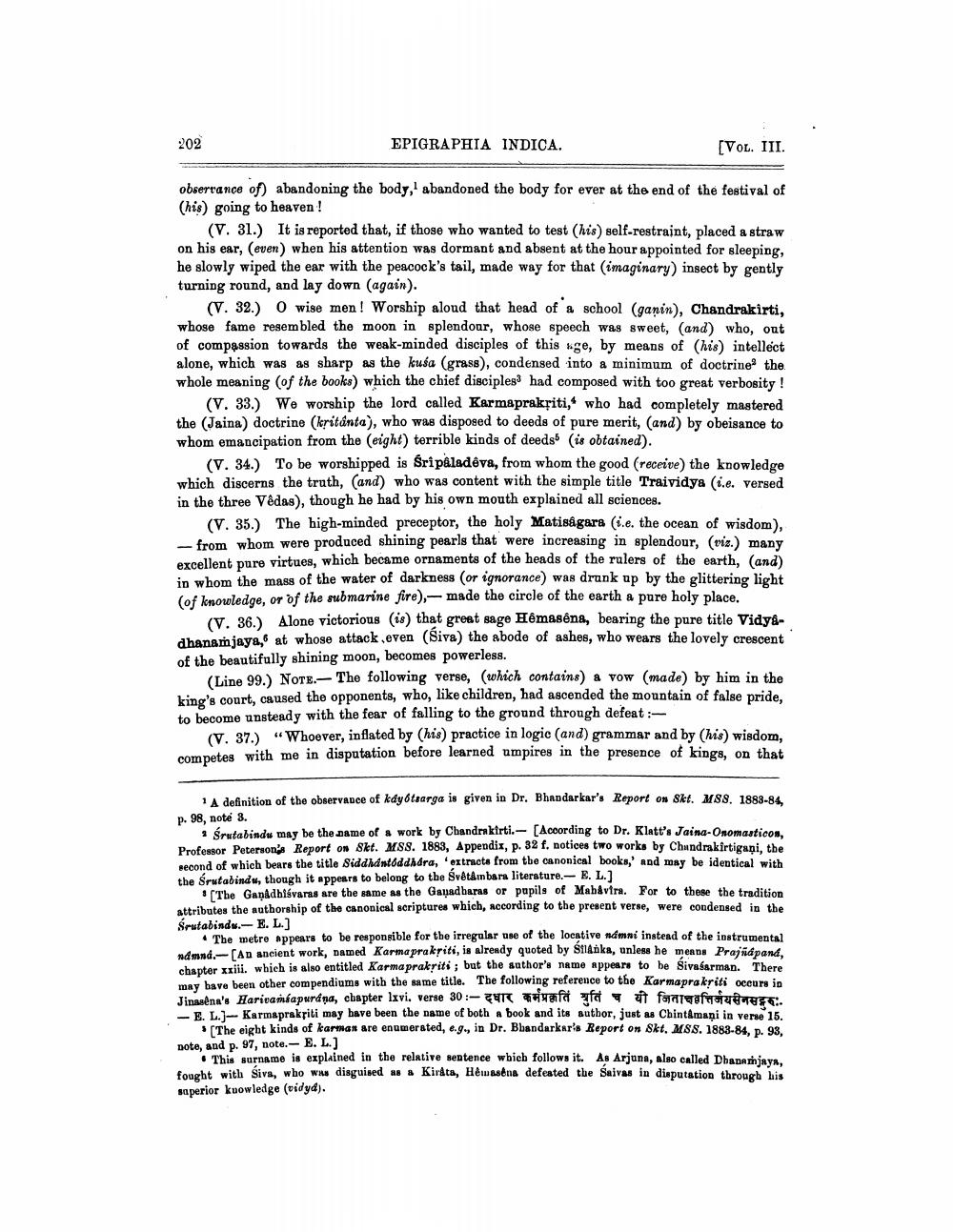________________
202
EPIGRAPHIA INDICA.
[VOL. III.
observance of) abandoning the body, abandoned the body for ever at the end of the festival of (his) going to heaven!
(V. 31.) It is reported that, if those who wanted to test (his) self-restraint, placed a straw on his ear, even when his attention was dormant and absent at the hour appointed for sleeping, he slowly wiped the ear with the peacock's tail, made way for that (imaginary) insect by gently turning round, and lay down (again).
(V. 32.) O wise men! Worship aloud that head of a school (ganin), Chandrakirti, whose fame resembled the moon in splendour, whose speech was sweet, (and) who, out of compassion towards the weak-minded disciples of this age, by means of (his) intellect alone, which was as sharp as the kusa (grass), condensed into a minimum of doctrine the whole meaning of the books) which the chief disciples: had composed with too great verbosity !
(V. 33.) We worship the lord called Karmaprakriti," who had completely mastered the (Jaina) doctrine (kritánta), who was disposed to deeds of pure merit, (and) by obeisance to whom emancipation from the eight) terrible kinds of deeds is obtained).
(V. 34.) To be worshipped is Sripaladeva, from whom the good (receive the knowledge which discerns the truth, (and) who was content with the simple title Traividya (i.6. versed in the three Vedas), though he had by his own mouth explained all sciences.
(V. 35.) The high-minded preceptor, the holy Matisagara (s.e. the ocean of wisdom), - from whom were produced shining pearls that were increasing in splendour, (vis.) many excellent pure virtues, which became ornaments of the heads of the rulers of the earth, (and) in whom the mass of the water of darkness (or ignorance) was drunk up by the glittering light (of knowledge, or of the submarine fire), --- made the circle of the earth a pure holy place.
(V. 36.) Alone victorious (is) that great sage Hêmasena, bearing the pure title Vidyadhanaṁjaya, at whose attack oven (Siva) the abode of ashes, who wears the lovely crescent of the beautifully shining moon, becomes powerless.
(Line 99.) NOTE.-The following verse, which contains) a vow (made) by him in the king's court, caused the opponents, who, like children, had ascended the mountain of false pride. to become unsteady with the fear of falling to the ground through defeat:
(V. 37.) “Whoever, inflated by (his) practice in logic (and) grammar and by (his) wisdom. competes with me in disputation before learned umpires in the presence of kings, on that
1 A definition of the observance of kdy 6tsarga is given in Dr. Bhandarkar's Report on Skt. M88. 1888-84 p. 98, noté 3.
Śrutabindu may be the name of a work by Chandrakirti.- (According to Dr. Klatt's Jaina-Onomasticon. Professor Peterson's Report on Skt. M88. 1883, Appendix, p. 32 f. notices two works by Chundrakirtigani, the second of which bears the title SiddhantoddAdra, extracts from the canonical books, and may be identical with the Srutabindu, though it appears to belong to the Svetambara literature.- B. L.)
The Ganadbisvaras are the same as the Ganadbaras or pupils of Mahavira. For to these the tradition attributes the authorship of the canonical scriptures which, according to the present verse, were condensed in the Srutabindu.-E. L.]
The metre appears to be responsible for the irregular use of the locative admni instead of the instrumental sdmod. [An ancient work, Damed Karma prakriti, is already quoted by Slanka, unless he means Prajlidpand. chapter xxiii. which is also entitled Karmaprakriti; but the author's name appears to be Sivasarman. There may bave been other compendiums with the same title. The following reference to the Karmaprakriti occurs in Jinasena's Harivaniapurana, chapter Ixvi. Verse 30 :- 3 et
4 for of oudes. - EL. - Karmaprakriti may have been the name of both a book and its author, just as Chintamani in verse 15.
The eight kinds of karman are enumerated, e.g., in Dr. Bhandarkar's Report on Skt. M88. 1883-84, p. 98, note, and p. 97, note.-E. L.)
This surname is explained in the relative sentence wbich follows it. As Arjuna, also called Dhanarhjayn, Bench with Siva, who was disguised as # Kiráta, Hêmesena defeated the Salvas in disputation through his saperior kuowledge (vidyd).




